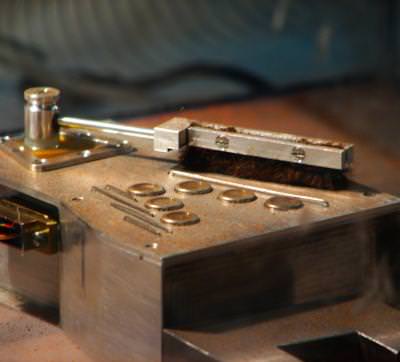A device that works as a windshield wiper to eliminate Mars dust from the sensors on Mars spacecraft. Credit: UC3M
In the past when we’ve discussed how dust accumulates on the solar panels of the Mars Exploration Rovers, Spirit and Opportunity, the most-often posted comments on those articles usually said something like, “They should have developed a windshield-wiper-like device to get rid of the dust!” Our readers will be happy to know such a device has now been invented. A team of researchers created extremely lightweight wipers that could be used to remove dust on Mars spacecraft. In fact, the researchers from Universidad Carlos III in Madrid, Spain developed the device for the Curiosity rover, but unfortunately, it wasn’t used for the MSL mission. But it’s ready to go for future Mars landers and rovers
While Curiosity doesn’t have solar panels, (it instead uses a longer-lasting RTG for power – a Thermoelectric Generator, which is a power system that produce electricity from the natural decay of plutonium-238) it does have sensors that can be affected by the accumulation of dust, such as the meteorological station, the Rover Environmental Monitoring Station (REMS).
The UC3M team created a brush made up of Teflon fibers, designed to clean the ultraviolet sensors on REMS.
“In our laboratories, we demonstrated that it worked correctly in the extreme conditions that it would have to endure on Mars,” said Luis Enrique Moreno, a professor who was head of the project, “with temperatures ranging between zero degrees and eighty below zero Celsius, and an atmospheric pressure one hundred times lower than that of the earth.”
Because weight is an issue when launching objects to other worlds, they used a very lightweight material for the wiper actuators, made from shape memory alloys (SMA), a very light nickel and titanium alloy that allows movement when the composite is heated.
“The main advantage is that these alloys produce a material that is very strong as related to its weight, that is, a thread of less than one millimeter can lift a weight of 4 or 5 kilograms,” said Moreno. “The problem presented by these mechanisms is that, because they are based on thermal effects, they are not as efficient as motor technology, although they are much lighter, which is a very important consideration in space missions.”
This group and other research groups at UC3M are currently working on a second, more elaborate prototype based on SMA technology. It will be used to clean dust from fixed meteorological stations that would be part of the MEIGA-METNET mission, a proposed Mars lander developed by Finnish Meteorological Institute, along with groups from Russia and Spain to do atmospheric observations, but which is not yet part of an official mission yet.
Here’s a look at the proposed unique landing proposed for METNET:
“We are also using this technology to develop the exoskeletons used to aid people with mobility problems, trying to substitute motors with these materials, in order to reduce the devices’ weight and increase agility in their use,” said Moreno, adding that this new product could even be used in the future to improve the joints on the gloves used by astronauts during EVAs.
Source: Universidad Carlos III


Seems like they could use a nozzle like device that blows compressed air over the area to be cleaned of the dust.
In the thin Martian air, that would be difficult.
It would work for that inflatable lander in the video, because that’s brought its own gas supply with it.
The cancelled 2001 Mars surveyor lander was to carry two dust mitigation experiments. One would try tilting a solar cell, to see if the dust slides off, while another would use electrostatic dust repulsion. This brush seems promising and very useful. The upcoming InSight lander, set to land during a Martian dust storm on 2016, could provide a useful test-bed for mitigation technologies. The craft will carry several auxiliary solar panels on the payload deck, it’ll be easy access for a brush similar to this one.
The cleaning system of the sensors on the actual photocameras is based on piezoelectric vibrating elements that cause the detachment of the dust. You only need that during nightime solar panels are placed in vertical position to facilitate the fall of the deposited dust on their surface and then turn on a slight vibration to facilitate the dust separation. Vertical positioning of the panels could be obtained with Shape Memory Alloys (SMA) actuators that does not require electric actuators and is lightweight. I suppose that such a system could uniformly clean the panels and prevent them from being scratched by hard dust particles.
Yeah, I’ve wondered before if vibration has ever been considered.
As for the scratching – doesn’t the technology exist for scratch-resistant films that could be used over delicate solar panels? I guess they’re just not optimized for space environments yet otherwise they’d already be on spacecraft.
Has anyone considered pressurizing the Martian atmosphere and “Blowing” the dust away?